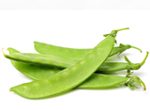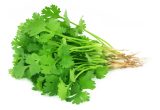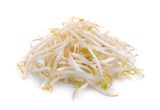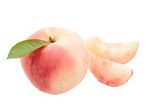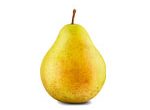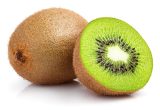Romaine lettuce

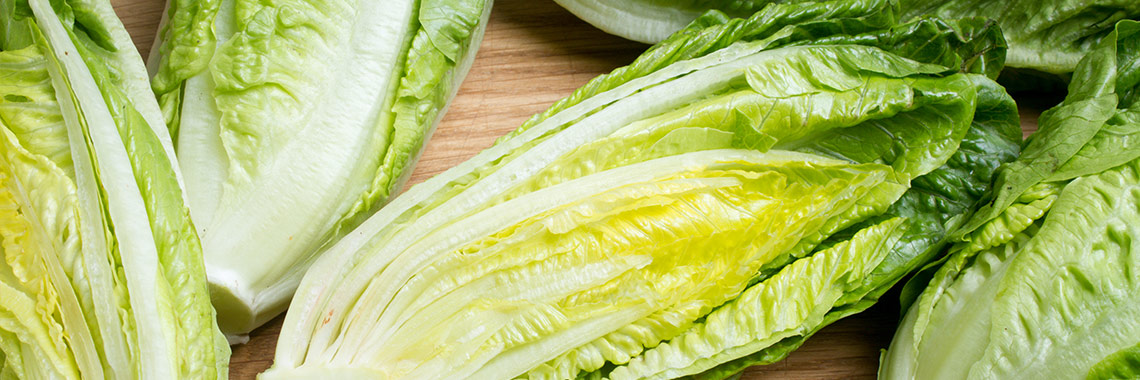
Description
- Romaine lettuce (Lactuca sativa) belongs to the Asteraceae family.
- It is a vegetable that is widely consumed throughout the world (Abu-Reidah, 2013).
- Romaine lettuce is a lettuce cultivar (Abu-Reidah, 2013).
PHYSICAL AND ORGANOLEPTIC CHARACTERISTICS
- Romaine lettuce leaves can be green or red and are crisp (Kim, 2016; Effendi, 2017).
- Polyphenol oxidase is the enzyme responsible for browning in romaine lettuce (Teng, 2019).
- The flavour of lettuce varies between cultivars (Bunning, 2010).
COMPOSITION CHARACTERISTICS (excluding macronutrients, vitamins and minerals)
- Some factors (genetic, agronomic and environmental) can influence the composition of lettuce (Ribas-Agusti, 2011; Kim, 2016).
- Three lettuce cultivars (romaine, baby and iceberg) have been analysed for phytochemical compounds. A total of 171 compounds were identified, including organic acids, phenolic acids (caffeoyl esters and p-coumaroyl esters) and flavonoids (quercetin glycosides) (Ribas-Agusti, 2011; Abu-Reidah, 2013).
- Among all lettuce cultivars, romaine lettuce is reported to be one of the richest in folates (vitamin B9), vitamin C, carotenoids, including mostly β-carotene and lutein, phenolic acids (70-94% of total phenolic content) and flavonoids (Kim, 2016).
RAW
The following values are approximate and depend on variety, season, ripeness, cultivation conditions, etc.
Romaine lettuce is low in energy*. On average, it provides 17.40 calories (kcal) per 100 g, i.e. 72.90 kJ.
COMPOSITION TABLES
For each nutrient, the tables provide information on the content, minimum and maximum values, as well as the percentage of the Dietary Reference Values (DRVs) for 100 g net of raw romaine lettuce.
*Regulation (EC) No 1924/2006 of the European Parliament and of the Council of 20 December 2006 on nutrition and health claims made on foods.
MACRONUTRIENTS
| Constituent (g) | Average content |
Min-Max per 100g |
DRV% |
|---|---|---|---|
| Water | 94,6 | 94 - 95,50 | - |
| Fibers | 2,10 | 1,40 - 3,70 | - |
| Carbohydrates | 1,20 | - | 0,46 |
| Sugars | 1,19 | 0,82 - 1,48 | 1,32 |
| Lipids | 0,30 | 0,16 - 0,50 | 0,43 |
| Saturated fat | 0,04 | 0,039 - NC | 0,20 |
| Protein | 1,24 | 1 - 1,50 | 2,48 |
| Constituent (g) | Amount | Min-Max | DRV% |
|---|---|---|---|
| Water | Ciqual 2020 | - | - |
| Fibers | Ciqual 2020 | - | - |
| Carbohydrates | Ciqual 2020 | - | Règlement (UE) N°1169/2011 du parlement Européen, et du conseil du 25 octobre 2011 |
| Sugars | Ciqual 2020 | - | Règlement (UE) N°1169/2011 du parlement Européen, et du conseil du 25 octobre 2011 |
| Lipids | Ciqual 2020 | - | Règlement (UE) N°1169/2011 du parlement Européen, et du conseil du 25 octobre 2011 |
| Saturated fat | Ciqual 2020 | - | Règlement (UE) N°1169/2011 du parlement Européen, et du conseil du 25 octobre 2011 |
| Protein | Ciqual 2020 | - | Règlement (UE) N°1169/2011 du parlement Européen, et du conseil du 25 octobre 2011 |
Zoom on carbohydrates
- Raw romaine lettuce contains less carbohydrates (1.20 g per 100 g) than the average carbohydrate content of raw vegetables: about 4.45 g per 100 g.
Zoom on fibres
- Raw romaine lettuce provides a significant amount of fibre, 2.10 g per 100 g.
- This amount is slightly lower than the average quantity found in raw vegetables (2.43 g per 100 g).
Zoom on proteins
- Its protein content (1.24 g per 100 g) is lower than the average amount found in raw vegetables (1.87 g per 100 g).
Zoom on lipids
- Its fat content (0.30 g per 100 g) is lower than the average amount found in raw vegetables (0.56 g per 100 g).
MINERALS AND TRACE ELEMENTS
| Constituent | Average content |
Min-Max per 100g |
DRV% |
|---|---|---|---|
| Calcium (mg) | 33 | 25 - 42 | 4,13 |
| Chloride (mg) | 48 | - | 6 |
| Copper (mg) | 0,048 | 0,033 - 0,064 | 4,80 |
| Iron (mg) | 0,97 | 0,64 - 1,54 | 6,93 |
| Iodine (µg) | 1,25 | 0,50 - 2 | 0,83 |
| Magnesium (mg) | 14 | 11 - 15 | 3,73 |
| Manganese (mg) | 0,16 | 0,042 - 0,23 | 8 |
| Phosphorus (mg) | 30 | 27 - 34 | 4,29 |
| Potassium (mg) | 247 | 183 - 291 | 12,35 |
| Selenium (µg) | 1 | - | 1,82 |
| Sodium (mg) | 8 | - | - |
| Zinc (mg) | 0,23 | 0,16 - 0,33 | 2,30 |
| Constituent | Amount | Min-Max | DRV% |
|---|---|---|---|
| Calcium (mg) | Ciqual 2020 | - | Règlement (UE) N°1169/2011 du parlement Européen, et du conseil du 25 octobre 2011 |
| Chloride (mg) | Ciqual 2020 | - | Règlement (UE) N°1169/2011 du parlement Européen, et du conseil du 25 octobre 2011 |
| Copper (mg) | Ciqual 2020 | - | Règlement (UE) N°1169/2011 du parlement Européen, et du conseil du 25 octobre 2011 |
| Iron (mg) | Ciqual 2020 | - | Règlement (UE) N°1169/2011 du parlement Européen, et du conseil du 25 octobre 2011 |
| Iodine (µg) | Ciqual 2020 | - | Règlement (UE) N°1169/2011 du parlement Européen, et du conseil du 25 octobre 2011 |
| Magnesium (mg) | Ciqual 2020 | - | Règlement (UE) N°1169/2011 du parlement Européen, et du conseil du 25 octobre 2011 |
| Manganese (mg) | Ciqual 2020 | - | Règlement (UE) N°1169/2011 du parlement Européen, et du conseil du 25 octobre 2011 |
| Phosphorus (mg) | Ciqual 2020 | - | Règlement (UE) N°1169/2011 du parlement Européen, et du conseil du 25 octobre 2011 |
| Potassium (mg) | Ciqual 2020 | - | Règlement (UE) N°1169/2011 du parlement Européen, et du conseil du 25 octobre 2011 |
| Selenium (µg) | Ciqual 2020 | - | Règlement (UE) N°1169/2011 du parlement Européen, et du conseil du 25 octobre 2011 |
| Sodium (mg) | Ciqual 2020 | - | - |
| Zinc (mg) | Ciqual 2020 | - | Règlement (UE) N°1169/2011 du parlement Européen, et du conseil du 25 octobre 2011 |
Zoom on minerals and trace elements
- Raw romaine lettuce contains a significant amount of potassium as it provides the equivalent of 12.35% of DRVs, i.e. 247 mg per 100 g.
- It also provides the equivalent of 8% of DRVs for manganese, i.e. 0.16 mg per 100 g.
- The amount of other minerals and trace elements represents less than 7% of DRVs.
VITAMINS
| Constituent | Average content |
Min-Max per 100g |
DRV% |
|---|---|---|---|
| Provitamin A Beta-carotene (µg) | 5 230 | 1770 - 8750 | - |
| Vitamin A equivalent (µg) | 871,67 | 295 - 1458,33 | 108,96 |
| Vitamin B1 (mg) | 0,072 | 0,058 - 0,092 | 6,55 |
| Vitamin B2 (mg) | 0,067 | 0,05 - 0,083 | 4,79 |
| Vitamin B3 (mg) | 0,31 | 0,27 - 0,36 | 1,94 |
| Vitamin B5 (mg) | 0,14 | 0,11 - 0,18 | 2,33 |
| Vitamin B6 (mg) | 0,074 | 0,05 - 0,10 | 5,29 |
| Vitamin B9 (µg) | 136 | - | 68 |
| Vitamin C (mg) | 14 | 0,80 - 24 | 17,50 |
| Vitamin E (mg) | 0,13 | 0,04 - 0,57 | 1,08 |
| Vitamin K1 (µg) | 103 | 69,70 - 129 | 137,33 |
| Constituent | Amount | Min-Max | DRV% |
|---|---|---|---|
| Provitamin A Beta-carotene (µg) | Ciqual 2020 | - | - |
| Vitamin A equivalent (µg) | Calcul à partir de la valeur Provitamine A Béta-carotène* | - | Règlement (UE) N°1169/2011 du parlement Européen, et du conseil du 25 octobre 2011 |
| Vitamin B1 (mg) | Ciqual 2020 | - | Règlement (UE) N°1169/2011 du parlement Européen, et du conseil du 25 octobre 2011 |
| Vitamin B2 (mg) | Ciqual 2020 | - | Règlement (UE) N°1169/2011 du parlement Européen, et du conseil du 25 octobre 2011 |
| Vitamin B3 (mg) | Ciqual 2020 | - | Règlement (UE) N°1169/2011 du parlement Européen, et du conseil du 25 octobre 2011 |
| Vitamin B5 (mg) | Ciqual 2020 | - | Règlement (UE) N°1169/2011 du parlement Européen, et du conseil du 25 octobre 2011 |
| Vitamin B6 (mg) | Ciqual 2020 | - | Règlement (UE) N°1169/2011 du parlement Européen, et du conseil du 25 octobre 2011 |
| Vitamin B9 (µg) | Ciqual 2020 | - | Règlement (UE) N°1169/2011 du parlement Européen, et du conseil du 25 octobre 2011 |
| Vitamin C (mg) | Ciqual 2020 | - | Règlement (UE) N°1169/2011 du parlement Européen, et du conseil du 25 octobre 2011 |
| Vitamin E (mg) | Ciqual 2020 | - | Règlement (UE) N°1169/2011 du parlement Européen, et du conseil du 25 octobre 2011 |
| Vitamin K1 (µg) | Ciqual 2020 | - | Règlement (UE) N°1169/2011 du parlement Européen, et du conseil du 25 octobre 2011 |
Zoom on vitamins
- Raw romaine lettuce is high in:
- vitamin K1 as it provides the equivalent of 137.33% of DRVs, i.e. 103 µg per 100 g;
- vitamin A as it provides the equivalent of 108.96% of DRVs, i.e. 871.67 µg per 100 g;
- vitamin B9 as it provides the equivalent of 68% of DRVs, i.e. 136 µg per 100 g. According to the Ciqual 2020 table, romaine lettuce is the raw vegetable that contains the most vitamin B9, after spinach, broccoli and asparagus (green and white).
- It is also a source of vitamin C as it provides the equivalent of 17.50% of DRVs, i.e. 14 mg per 100 g.
- The quantity of other vitamins represents less than 7% of DRVs.
*Calculation made: Beta Carotene / 6 + retinol
POLYPHENOLS
Nutrition and health claims
According to the definitions of nutrition claims as set out in Regulation (EC) No 1924/2006 on nutrition and health claims, and in view of the composition of raw romaine lettuce, the following claims may be used:
NUTRITION CLAIMS OF RAW ROMAINE LETTUCE
- Low in energy (100 g of raw romaine lettuce provide less than 40 kcal)
- High in vitamin K1 (100 g of raw romaine lettuce provide more than 30% of DRVs)
- High in vitamin A (100 g of raw romaine lettuce provide more than 30% of DRVs)
- High in vitamin B9 (100 g of raw romaine lettuce provide more than 30% of DRVs)
- Source of vitamin C (100 g of raw romaine lettuce provide more than 15% of DRVs)
- Fat-free (100 g of raw romaine lettuce contain less than 0.5 g of fat)
- Low in sugar (100 g of raw romaine lettuce contain less than 5 g of sugar)
HEALTH CLAIMS (for a consumption of 100 g of raw romaine lettuce)
Vitamin K1
- Vitamin K1 contributes to:
- maintenance of normal bones,
- normal blood clotting.
Vitamin A
- Vitamin A has a role in the process of cell specialisation.
- Vitamin A contributes to:
- maintenance of normal skin,
- maintenance of normal mucous membranes,
- maintenance of normal vision,
- normal iron metabolism,
- normal function of the immune system.
Folates or vitamin B9
- Folates contribute to:
- maternal tissue growth during pregnancy,
- normal amino acid synthesis,
- normal blood formation,
- normal homocysteine metabolism,
- normal psychological function,
- normal function of the immune system,
- reduction of tiredness and fatigue.
- Folates have a role in the process of cell division.
Vitamin C
- Vitamin C contributes to:
- normal function of the immune system during and after intense physical exercise,
- normal collagen formation for the normal function of blood vessels,
- normal collagen formation for the normal function of bones,
- normal collagen formation for the normal function of cartilage,
- normal collagen formation for the normal function of gums,
- normal collagen formation for the normal function of skin,
- normal collagen formation for the normal function of teeth,
- normal energy-yielding metabolism,
- normal functioning of the nervous system,
- normal psychological function,
- normal function of the immune system,
- protection of cells from oxidative stress,
- reduction of tiredness and fatigue,
- regeneration of the reduced form of vitamin E.
- Vitamin C increases iron absorption.
References
- Agence nationale de sécurité sanitaire de l’alimentation, de l’environnement et du travail. Table de composition nutritionnelle des aliments Ciqual 2020. Consultée le 14/09/2020 depuis le site internet Ciqual https://ciqual.anses.fr/
- Agence nationale de sécurité sanitaire de l’alimentation, de l’environnement et du travail. Table de composition nutritionnelle des aliments Ciqual pour le calcul des apports nutritionnels CALNUT 2020. Consultée le 14/09/2020 depuis le site internet Ciqual https://ciqual.anses.fr/
- Abu-Reidah IM, Contreras MM, Arráez-Román D, Segura-Carretero A, Fernández-Gutiérrez A. Reversed-phase ultra-high-performance liquid chromatography coupled to electrospray ionization-quadrupole-time-of-flight mass spectrometry as a powerful tool for metabolic profiling of vegetables: Lactuca sativa as an example of its application. J Chromatogr 2013;1313:212-27.
- Bunning ML, Kendall PA, Stone MB, Stonaker FH, Stushnoff C. Effects of seasonal variation on sensory properties and total phenolic content of 5 lettuce cultivars. J Food Sci. 2010;75(3):S156-61.
- Effendi H, Wahyuningsih S, Wardiatno Y. The use of nile tilapia (Oreochromis niloticus) cultivation wastewater for the production of romaine lettuce (Lactuca sativa L. var. longifolia) in water recirculation system. Applied Water Science. 2017;7(6): 3055–3063.
- Kim MJ, Moon Y, Tou JC, Mou B, Waterland NL. Nutritional value, bioactive compounds and health benefits of lettuce (Lactuca sativa L.). Journal of Food Composition and Analysis. 2016;49: 19–34.
- Règlement (CE) N° 1924/2006 du Parlement européen et du Conseil du 20 décembre 2006 concernant les allégations nutritionnelles et de santé portant sur les denrées alimentaires.
- Règlement (UE) N°432/2012 de la Commission du 16 mai 2012 établissant une liste des allégations de santé autorisées portant sur les denrées alimentaires, autres que celles faisant référence à la réduction du risque de maladie ainsi qu’au développement et à la santé infantiles.
- Règlement (UE) n°1169/2011 du Parlement européen et du Conseil du 25 octobre 2011 concernant l’information des consommateurs sur les denrées alimentaires, modifiant les règlements (CE) n°1924/2006 et (CE) n°1925/2006 du Parlement européen et de Conseil et abrogeant la directive 87/250/CEE de la Commission, la directive 90/496/CEE du Conseil, la directive 1999/10/CE de la Commission, la directive 200/13/CE du Parlement européen et du Conseil, les directives 2002/67/CE et 2008/5/CE de la Commission et le règlement (CE) n°608/2004 de la Commission.
- Ribas-Agustí A, Gratacós-Cubarsí M, Sárraga C, García-Regueiro JA, Castellari M. Analysis of eleven phenolic compounds including novel p-coumaroyl derivatives in lettuce (Lactuca sativa L.) by ultra-high-performance liquid chromatography with photodiode array and mass spectrometry detection. Phytochem Anal. 2011;22(6):555-63.
- Teng Z, Luo Y, Bornhorst ER, Zhou B, Simko I, Trouth F. Identification of romaine lettuce (Lactuca sativa var. longifolia) Cultivars with reduced browning discoloration for fresh-cut processing.Postharvest Biology and Technology. 2019;156: 110931.




